Biomass Potential and Utilization in Worldwide Research Trends—A Bibliometric Analysis
Abstract
:1. Introduction
Biomass Potential
2. Materials and Methods
3. Results and Discussion
3.1. Trend Publications
3.2. Worldwide Distribution of Publications
3.3. Keywords
3.4. Figures with VOSviewer
3.5. Type and Language of Publications
3.6. Subject Categories
3.7. Relevant Journals
3.8. Main Authors
4. Conclusions
Author Contributions
Funding
Institutional Review Board Statement
Informed Consent Statement
Data Availability Statement
Conflicts of Interest
References
- World Bioenergy Association. Global Bioenergy Statistics 2021. 2021. Available online: https://www.worldbioenergy.org/uploads/211214WBAGBS2021.pdf (accessed on 5 January 2022).
- Zsiborács, H.; Baranyai, N.H.; Pintér, G. Aspects of Determining the Energy Storage System Size Linked to Household-Sized Power Plants in Hungary in Accordance with the Regulatory Needs of the Electric Energy System. Sustainability 2022, 14, 2622. [Google Scholar]
- United Nations. A/RES/70/1 Transforming Our World: The 2030 Agenda for Sustainable Development; Seventieth United Nations General Assembly: New York, NY, USA, 2015; Volume 16301, pp. 1–35. [Google Scholar]
- Rulli, M.C.; Bellomi, D.; Cazzoli, A.; De Carolis, G.; D’Odorico, P. The water-land-food nexus of first-generation biofuels. Sci. Rep. 2016, 6, 22521. [Google Scholar] [CrossRef] [PubMed] [Green Version]
- Smith, P.; Gregory, P.J.; van Vuuren, D.; Obersteiner, M.; Havlík, P.; Rounsevell, M.; Woods, J.; Stehfest, E.; Bellarby, J. Competition for land. Philos. Trans. R. Soc. B Biol. Sci. 2010, 365, 2941–2957. [Google Scholar] [CrossRef] [PubMed] [Green Version]
- Birkner, Z.; Németh, K.; Péter, E.; Weisz, M. Regional Development With Renewable Energy Utilization. Acta Sci. Pol. Oeconomia 2011, 103, 5–12. Available online: http://acta_oeconomia.sggw.pl/pdf/Acta_Oeconomia_10_3_2011.pdf#page=7 (accessed on 15 December 2021).
- Haberl, H.; Erb, K.-H.; Krausmann, F. Human Appropriation of Net Primary Production: Patterns, Trends, and Planetary Boundaries. Annu. Rev. Environ. Resour. 2014, 39, 363–391. [Google Scholar] [CrossRef]
- Muscat, A.; de Olde, E.M.; de Boer, I.; Ripoll-Bosch, R. The battle for biomass: A systematic review of food-feed-fuel competition. Glob. Food Secur. 2020, 25, 100330. [Google Scholar] [CrossRef]
- Kopetz, H. Renewable resources: Build a biomass energy market. Nature 2013, 494, 29–31. [Google Scholar] [CrossRef]
- Dombi, M.; Kuti, I.; Balogh, P. Aspects of the sustainable utilization of renewable energy sources. Appl. Stud. Agribus. Commer. 2012, 6, 91–94. [Google Scholar] [CrossRef]
- Popp, J.; Harangi-Rákos, M.; Pető, K.; Nagy, A. Bioenergy: Risks to food-, energy- and environmental security. Appl. Stud. Agribus. Commer. 2013, 7, 121–130. [Google Scholar] [CrossRef]
- International Energy Agency. Market Analysis and Forecast from 2019 to 2024. 2019. Available online: https://iea.blob.core.windows.net/assets/7f8aed40-89af-4348-be19-c8a67df0b9ea/Energy_Technology_Perspectives_2020_PDF.pdf (accessed on 10 January 2022).
- Brodny, J.; Tutak, M. Analyzing Similarities between the European Union Countries in Terms of the Structure and Volume of Energy Production from Renewable Energy Sources. Energies 2020, 13, 913. [Google Scholar] [CrossRef] [Green Version]
- Balat, M.; Ayar, G. Biomass Energy in the World, Use of Biomass and Potential Trends. Energy Sources 2005, 27, 931–940. [Google Scholar] [CrossRef]
- U.S. Department of Energy. 2016 Billion-Ton Report: Advancing Domestic Resources for a Thriving Bioeconomy. In Economic Availability of Feedstocks; Langholtz, M.H., Stokes, B.J., Eaton, L.M., Eds.; Oak Ridge National Laboratory: Oak Ridge, TN, USA, 2016; Volume 1. [Google Scholar]
- Szőllősi, L.; Béres, E.; Szűcs, I. Effects of modern technology on broiler chicken performance and economic indicators–A Hungarian case study. Ital. J. Anim. Sci. 2021, 20, 188–194. [Google Scholar] [CrossRef]
- Lin, C.-Y.; Lu, C. Development perspectives of promising lignocellulose feedstocks for production of advanced generation biofuels: A review. Renew. Sustain. Energy Rev. 2021, 136, 110445. [Google Scholar] [CrossRef]
- Mizik, T. Economic Aspects and Sustainability of Ethanol Production—A Systematic Literature Review. Energies 2021, 14, 6137. [Google Scholar] [CrossRef]
- Mizik, T.; Gyarmati, G. Clean Technologies Economic and Sustainability of Biodiesel Production—A Systematic Literature Review. Econ. Sustain. Biodiesel Prod. Syst. Lit. Rev. 2021, 3, 19–36. [Google Scholar]
- World Bioenergy Association. Global Biomass Potential towards 2035. 2016. Available online: http://www.worldbioenergy.org/uploads/Factsheet_Biomasspotential.pdf (accessed on 10 January 2022).
- EERE. Bioenergy Frequently Asked Questions | Department of Energy. Office of Energy Efficiency & Renewable Energy. Available online: https://www.energy.gov/eere/bioenergy/bioenergy-frequently-asked-questions#3 (accessed on 12 January 2022).
- Ladanai, S.; Vinterbäck, J. Global Potential of Sustainable Biomass for Energy. 2009. Available online: http://pub.epsilon.slu.se/4523/1/ladanai_et_al_100211.pdf (accessed on 13 January 2022).
- EUBIA. Bioenergy Production Potential—European Biomass Industry Association. European Biomass Industry Association. Available online: https://www.eubia.org/cms/wiki-biomass/bioenergy-production-potential/ (accessed on 13 January 2022).
- Nie, Y.; Li, J.; Wang, C.; Huang, G.; Fu, J.; Chang, S.; Li, H.; Ma, S.; Yu, L.; Cui, X.; et al. A fine-resolution estimation of the biomass resource potential across China from 2020 to 2100. Resour. Conserv. Recycl. 2021, 176, 105944. [Google Scholar] [CrossRef]
- Hiloidhari, M.; Das, D.; Baruah, D.C. Bioenergy potential from crop residue biomass in India. Renew. Sustain. Energy Rev. 2014, 32, 504–512. [Google Scholar] [CrossRef]
- Gregory, J.; Stern, D.I. Fuel choices in rural Maharashtra. Biomass Bioenergy 2014, 70, 302–314. [Google Scholar] [CrossRef] [Green Version]
- Natarajan, K.; Latva-Käyrä, P.; Zyadin, A.; Chauhan, S.; Singh, H.; Pappinen, A.; Pelkonen, P. Biomass Resource Assessment and Existing Biomass Use in the Madhya Pradesh, Maharashtra, and Tamil Nadu States of India. Challenges 2015, 6, 158–172. [Google Scholar] [CrossRef] [Green Version]
- Szarka, N.; Haufe, H.; Lange, N.; Schier, F.; Weimar, H.; Banse, M.; Sturm, V.; Dammer, L.; Piotrowski, S.; Thrän, D. Biomass flow in bioeconomy: Overview for Germany. Renew. Sustain. Energy Rev. 2021, 150, 111449. [Google Scholar] [CrossRef]
- Mao, G.; Zou, H.; Chen, G.; Du, H.; Zuo, J. Past, current and future of biomass energy research: A bibliometric analysis. Renew. Sustain. Energy Rev. 2015, 52, 1823–1833. [Google Scholar] [CrossRef]
- Ranjbari, M.; Esfandabadi, Z.S.; Quatraro, F.; Vatanparast, H.; Lam, S.S.; Aghbashlo, M.; Tabatabaei, M. Biomass and organic waste potentials towards implementing circular bioeconomy platforms: A systematic bibliometric analysis. Fuel 2022, 318, 123585. [Google Scholar] [CrossRef]
- Bugge, M.M.; Hansen, T.; Klitkou, A. What Is the Bioeconomy? A Review of the Literature. Sustainability 2016, 8, 691. [Google Scholar] [CrossRef] [Green Version]
- Stegmann, P.; Londo, M.; Junginger, M. The circular bioeconomy: Its elements and role in European bioeconomy clusters. Resour. Conserv. Recycl. X 2020, 6, 100029. [Google Scholar] [CrossRef]
- Li, Y.; Rezgui, Y.; Zhu, H. District heating and cooling optimization and enhancement–Towards integration of renewables, storage and smart grid. Renew. Sustain. Energy Rev. 2017, 72, 281–294. [Google Scholar] [CrossRef]
- Kumar, A.; Kumar, N.; Baredar, P.; Shukla, A. A review on biomass energy resources, potential, conversion and policy in India. Renew. Sustain. Energy Rev. 2015, 45, 530–539. [Google Scholar] [CrossRef]
- Perea-Moreno, M.-A.; Manzano-Agugliaro, F.; Perea-Moreno, A.-J. Sustainable Energy Based on Sunflower Seed Husk Boiler for Residential Buildings. Sustainability 2018, 10, 3407. [Google Scholar] [CrossRef] [Green Version]
- Osman, A.I.; Qasim, U.; Jamil, F.; Al-Muhtaseb, A.H.; Abu Jrai, A.; Al-Riyami, M.; Al-Maawali, S.; Al-Haj, L.; Al-Hinai, A.; Al-Abri, M.; et al. Bioethanol and biodiesel: Bibliometric mapping, policies and future needs. Renew. Sustain. Energy Rev. 2021, 152, 111677. [Google Scholar] [CrossRef]
- Alalwan, H.A.; Alminshid, A.; Aljaafari, H.A. Promising evolution of biofuel generations. Subject review. Renew. Energy Focus 2019, 28, 127–139. [Google Scholar] [CrossRef]
- Peng, F.; Peng, P.; Xu, F.; Sun, R.-C. Fractional purification and bioconversion of hemicelluloses. Biotechnol. Adv. 2012, 30, 879–903. [Google Scholar] [CrossRef]
- Arteaga-Pérez, L.E.; Segura, C.; Espinoza, D.; Radovic, L.R.; Jiménez, R. Torrefaction of Pinus radiata and Eucalyptus globulus: A combined experimental and modeling approach to process synthesis. Energy Sustain. Dev. 2015, 29, 13–23. [Google Scholar] [CrossRef]
- Soltero, V.; Chacartegui, R.; Ortiz, C.; Velázquez, R. Potential of biomass district heating systems in rural areas. Energy 2018, 156, 132–143. [Google Scholar] [CrossRef]
- Vassilev, S.V.; Vassileva, C.G.; Vassilev, V.S. Advantages and disadvantages of composition and properties of biomass in comparison with coal: An overview. Fuel 2015, 158, 330–350. [Google Scholar] [CrossRef]
- Plate, R.R.; Monroe, M.C.; Oxarart, A. June 2010 Article Number 3FEA7 Public Perceptions of Using Woody Biomass as a Renewable Energy Source. J. Ext. 2010, 48, 1–15. [Google Scholar]
- Szakály, Z.; Balogh, P.; Kontor, E.; Gabnai, Z.; Bai, A. Attitude toward and Awareness of Renewable Energy Sources: Hungarian Experience and Special Features. Energies 2020, 14, 22. [Google Scholar] [CrossRef]
- Vassilev, S.V.; Baxter, D.; Andersen, L.K.; Vassileva, C.G. An overview of the composition and application of biomass ash. Fuel 2013, 105, 19–39. [Google Scholar] [CrossRef]
- Perea-Moreno, A.J.; Perea-Moreno, M.Á.; Hernandez-Escobedo, Q.; Manzano-Agugliaro, F. Towards forest sustainability in Mediterranean countries using biomass as fuel for heating. J. Clean. Prod. 2017, 156, 624–634. [Google Scholar] [CrossRef]
- Fang, Y.; Paul, M.C.; Varjani, S.; Li, X.; Park, Y.-K.; You, S. Concentrated solar thermochemical gasification of biomass: Principles, applications, and development. Renew. Sustain. Energy Rev. 2021, 150, 111484. [Google Scholar] [CrossRef]
- Bai, Z.; Liu, Q.; Gong, L.; Lei, J. Thermodynamic and economic analysis of a solar-biomass gasification system with the production of methanol and electricity. Energy Procedia 2018, 152, 1045–1050. [Google Scholar] [CrossRef]
- Popp, J.; Balogh, P.; Oláh, J.; Kot, S.; Rákos, M.H.; Lengyel, P. Social Network Analysis of Scientific Articles Published by Food Policy. Sustainability 2018, 10, 577. [Google Scholar] [CrossRef] [Green Version]
- Tranfield, D.; Denyer, D.; Smart, P. Towards a Methodology for Developing Evidence-Informed Management Knowledge by Means of Systematic Review. Br. J. Manag. 2003, 14, 207–222. [Google Scholar] [CrossRef]
- Seuring, P.D.S.; Müller, P.D.M.; Westhaus, M.; Morana, R. Conducting a Literature Review—The Example of Sustainability in Supply Chains. In Research Methodologies in Supply Chain Management; Springer: Berlin, Germany, 2005; pp. 91–106. [Google Scholar] [CrossRef]
- Lancho-Barrantes, B.S.; Cantu-Ortiz, F.J. Quantifying the publication preferences of leading research universities. Science 2021, 126, 2269–2310. [Google Scholar] [CrossRef] [PubMed]
- Niñerola, A.; Sánchez-Rebull, M.V.; Hernández-Lara, A.B. Tourism research on sustainability: A bibliometric analysis. Sustainability 2019, 11, 1377. [Google Scholar] [CrossRef] [Green Version]
- Salmerón-Manzano, E.; Manzano-Agugliaro, F. The Higher Education Sustainability through Virtual Laboratories: The Spanish University as Case of Study. Sustainability 2018, 10, 4040. [Google Scholar] [CrossRef] [Green Version]
- Gomez-Jauregui, V.; Gomez-Jauregui, C.; Manchado, C.; Otero, C. Information management and improvement of citation indices. Int. J. Inf. Manag. 2014, 34, 257–271. [Google Scholar] [CrossRef]
- Sugimoto, C.R.; Larivière, V. Measuring Research: What Everyone Needs to Know; Oxford University Press: Oxford, UK, 2018; p. 168. ISBN 9780190640125. [Google Scholar]
- Heradio, R.; de la Torre, L.; Galan, D.; Cabrerizo, F.J.; Herrera-Viedma, E.; Dormido, S. Virtual and remote labs in education: A bibliometric analysis. Comput. Educ. 2016, 98, 14–38. [Google Scholar] [CrossRef]
- Duque-Acevedo, M.; Belmonte-Ureña, L.J.; Yakovleva, N.; Camacho-Ferre, F. Analysis of the Circular Economic Production Models and Their Approach in Agriculture and Agricultural Waste Biomass Management. Int. J. Environ. Res. Public Heal. 2020, 17, 9549. [Google Scholar] [CrossRef]
- De La Cruz-Lovera, C.; Perea-Moreno, A.-J.; De La Cruz-Fernández, J.-L.; Alvarez-Bermejo, J.A.; Manzano-Agugliaro, F. Worldwide Research on Energy Efficiency and Sustainability in Public Buildings. Sustainability 2017, 9, 1294. [Google Scholar] [CrossRef] [Green Version]
- Gong, R.; Xue, J.; Zhao, L.; Zolotova, O.; Ji, X.; Xu, Y. A Bibliometric Analysis of Green Supply Chain Management Based on the Web of Science (WOS) Platform. Sustainability 2019, 11, 3459. [Google Scholar] [CrossRef] [Green Version]
- Perea-Moreno, M.-A.; Samerón-Manzano, E.; Perea-Moreno, A.-J. Biomass as Renewable Energy: Worldwide Research Trends. Sustainability 2019, 11, 863. [Google Scholar] [CrossRef] [Green Version]
- Ji, X.; Liu, Y.; Meng, J.; Wu, X. Global supply chain of biomass use and the shift of environmental welfare from primary exploiters to final consumers. Appl. Energy 2020, 276, 115484. [Google Scholar] [CrossRef]
- Luis, E.C.; Celma, D. Circular Economy. A Review and Bibliometric Analysis. Sustainability 2020, 12, 6381. [Google Scholar] [CrossRef]
- Duquenne, M.; Prost, H.; Schöpfel, J.; Dumeignil, F. Open Bioeconomy—A Bibliometric Study on the Accessibility of Articles in the Field of Bioeconomy. Publications 2020, 8, 55. [Google Scholar] [CrossRef]
- Pandey, A.; Soccol, C.R.; Nigam, P.; Soccol, V.T. Biotechnological potential of agro-industrial residues. I: Sugarcane bagasse. Bioresour. Technol. 2000, 74, 69–80. [Google Scholar] [CrossRef]
- Brennan, L.; Owende, P. Biofuels from microalgae—A review of technologies for production, processing, and extractions of biofuels and co-products. Renew. Sustain. Energy Rev. 2010, 14, 557–577. [Google Scholar] [CrossRef]
- Naik, S.N.N.; Goud, V.V.; Rout, P.K.; Dalai, A.K. Production of first and second generation biofuels: A comprehensive review. Renew. Sustain. Energy Rev. 2010, 14, 578–597. [Google Scholar] [CrossRef]
- Weiland, P. Biogas production: Current state and perspectives. Appl. Microbiol. Biotechnol. 2010, 85, 849–860. [Google Scholar] [CrossRef]
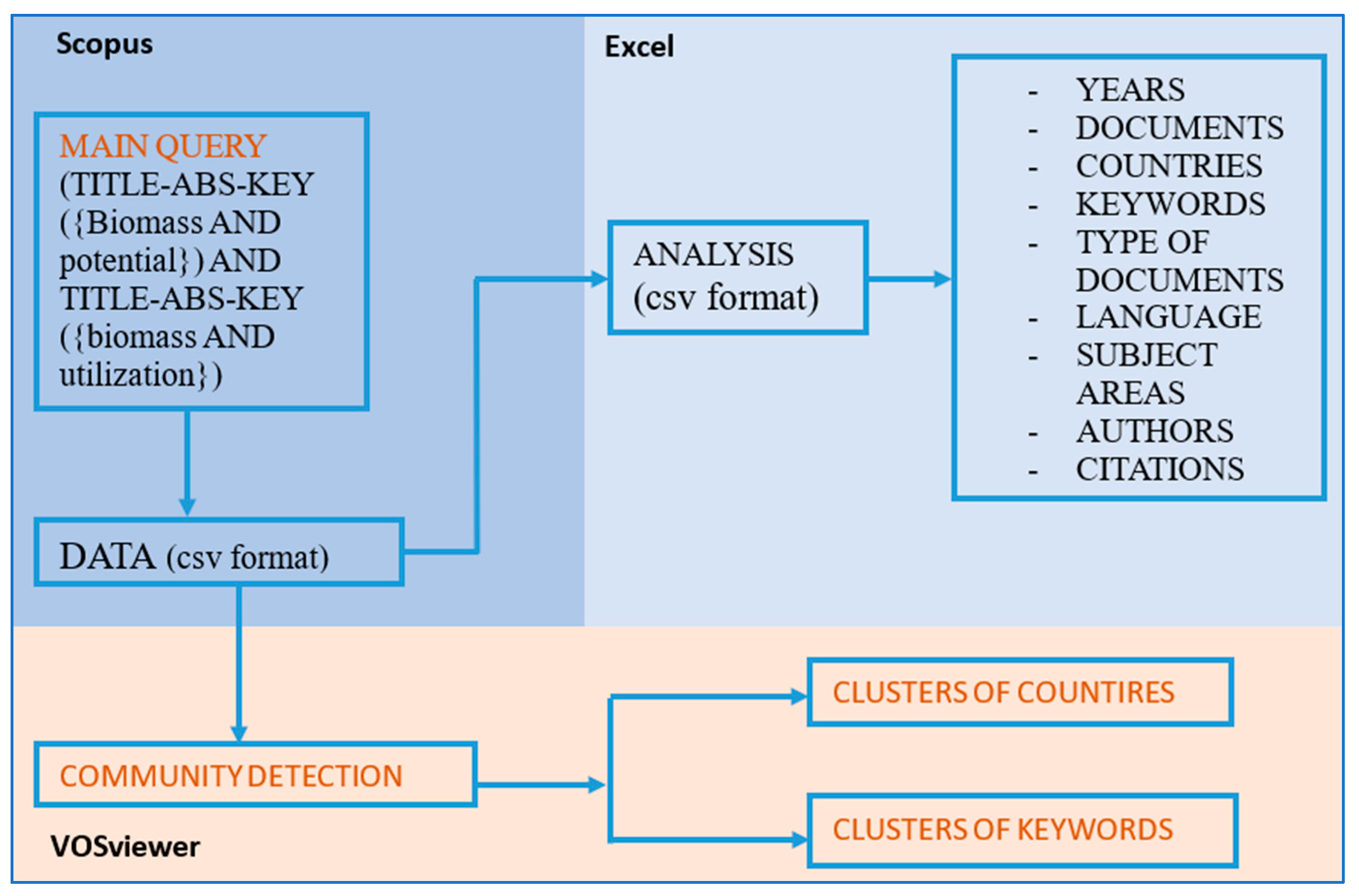
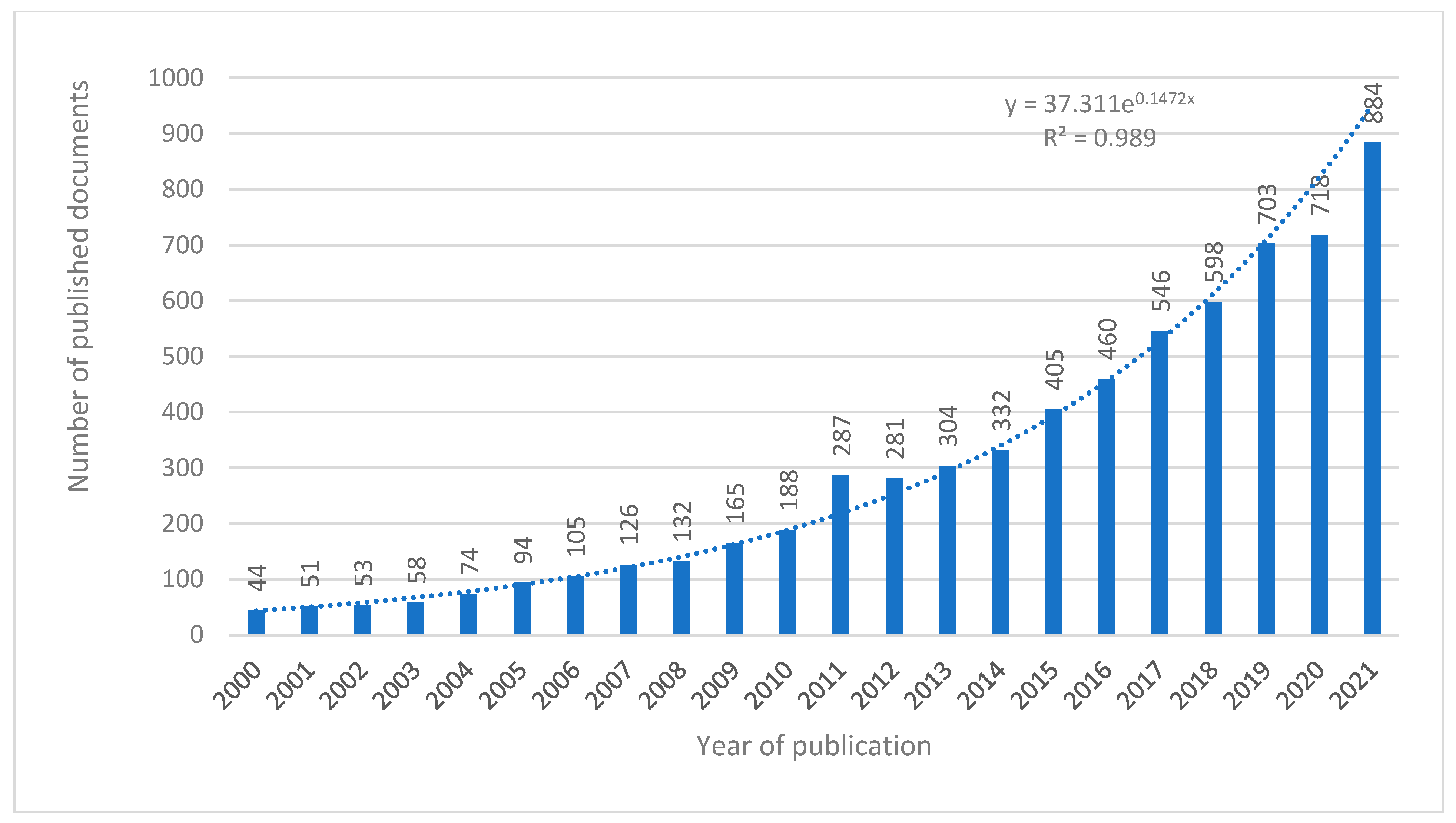



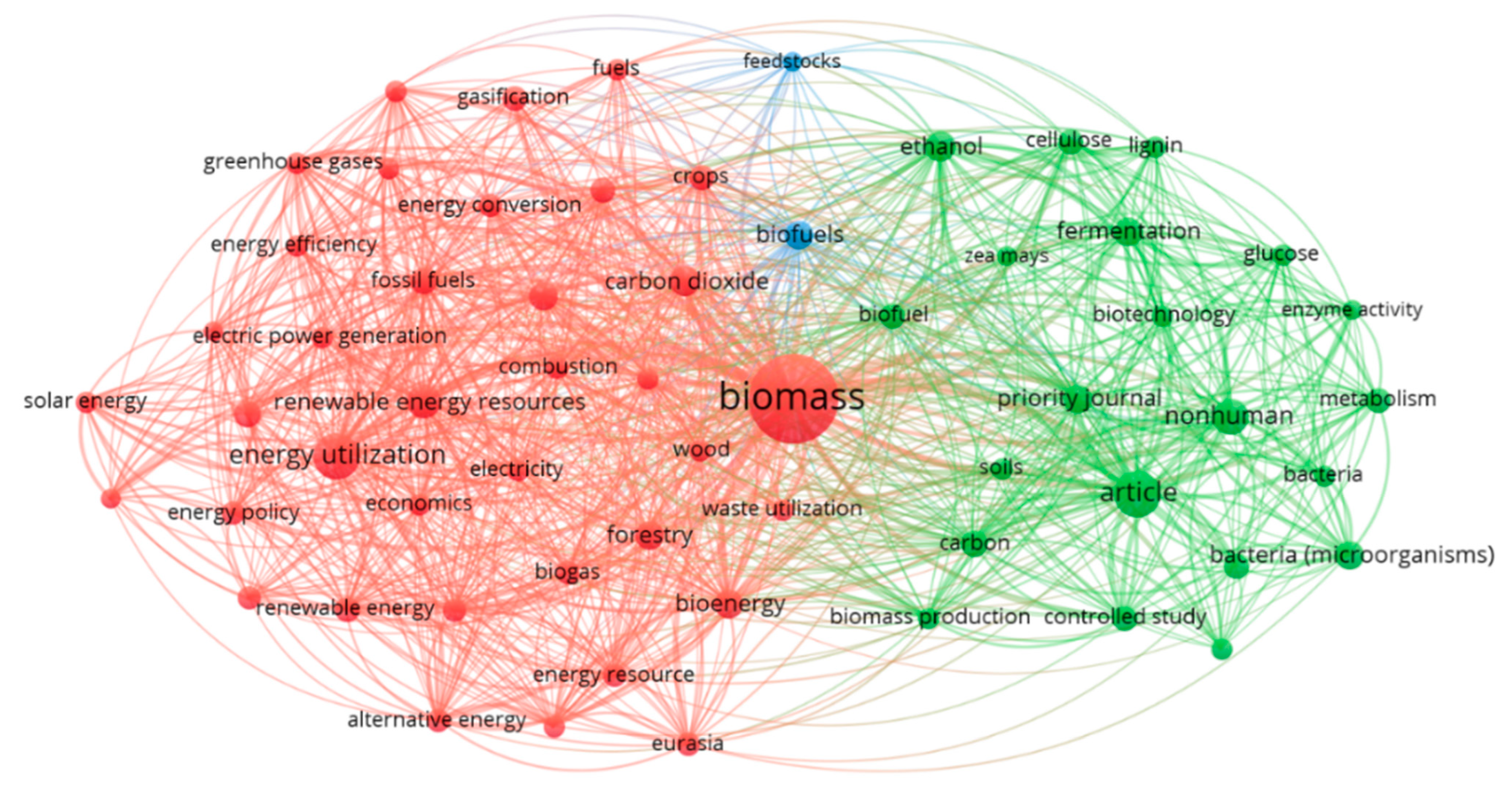
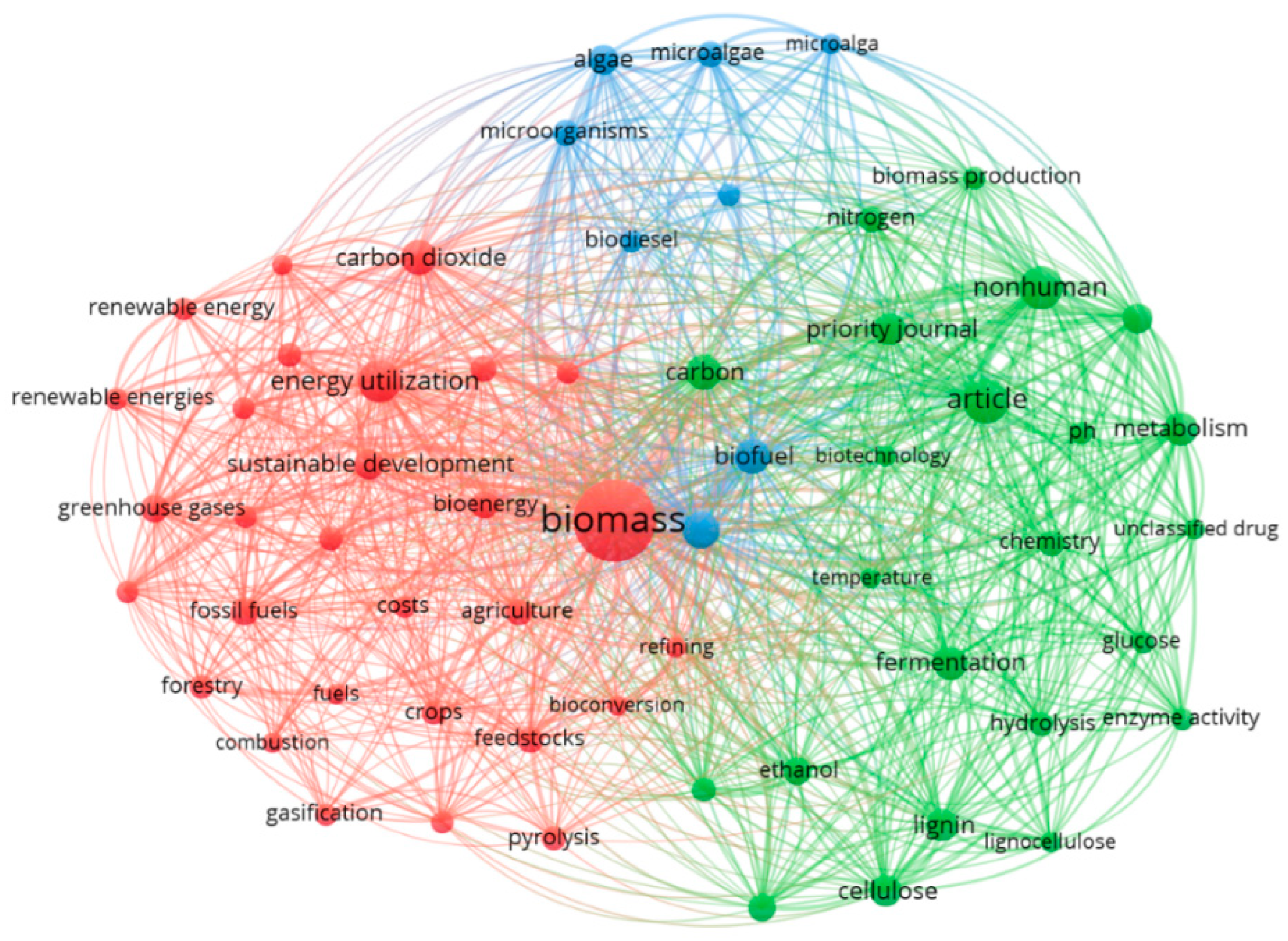
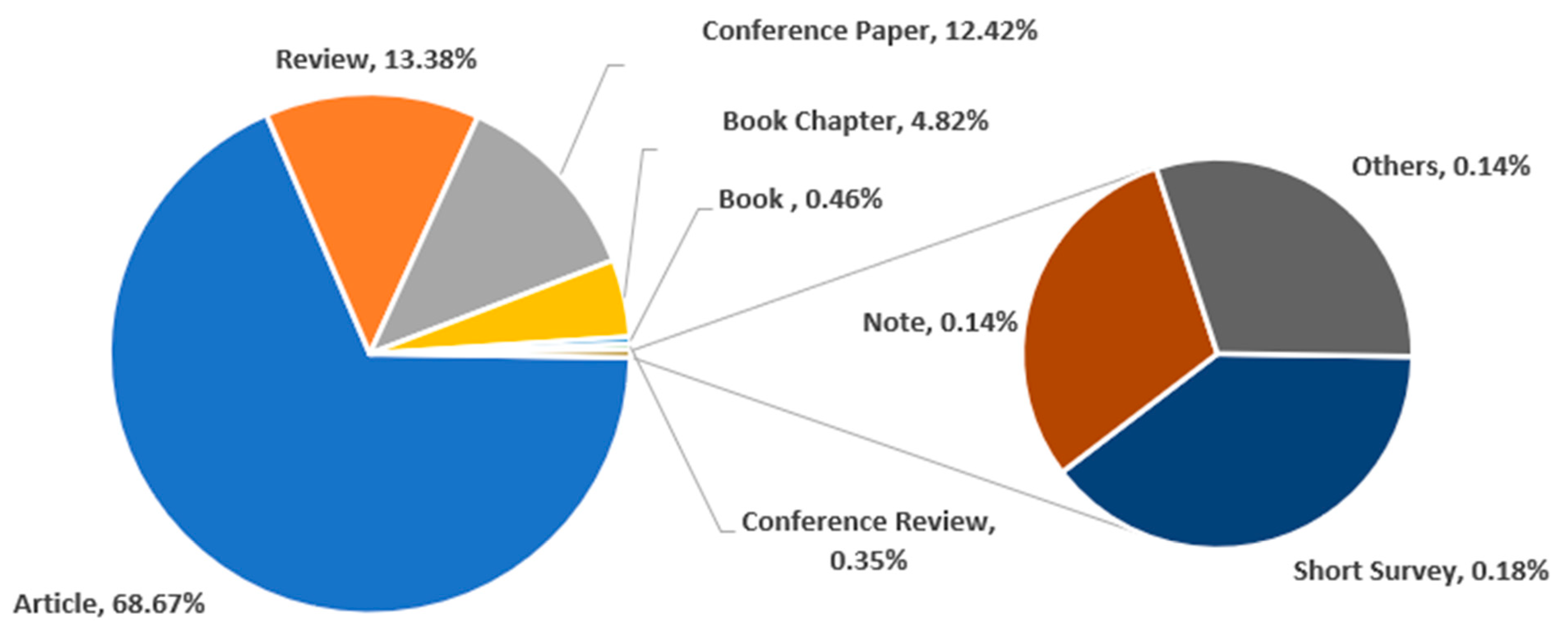
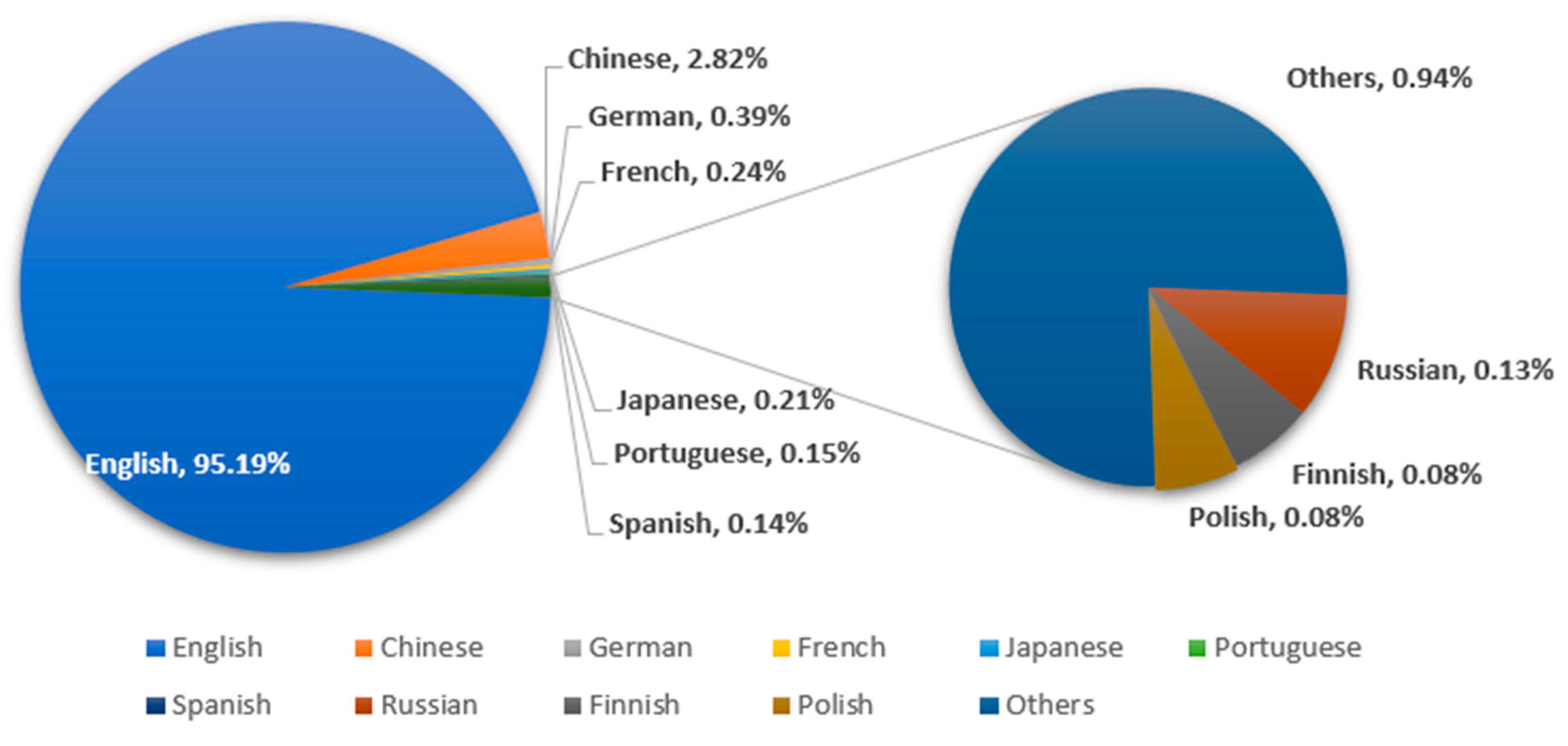

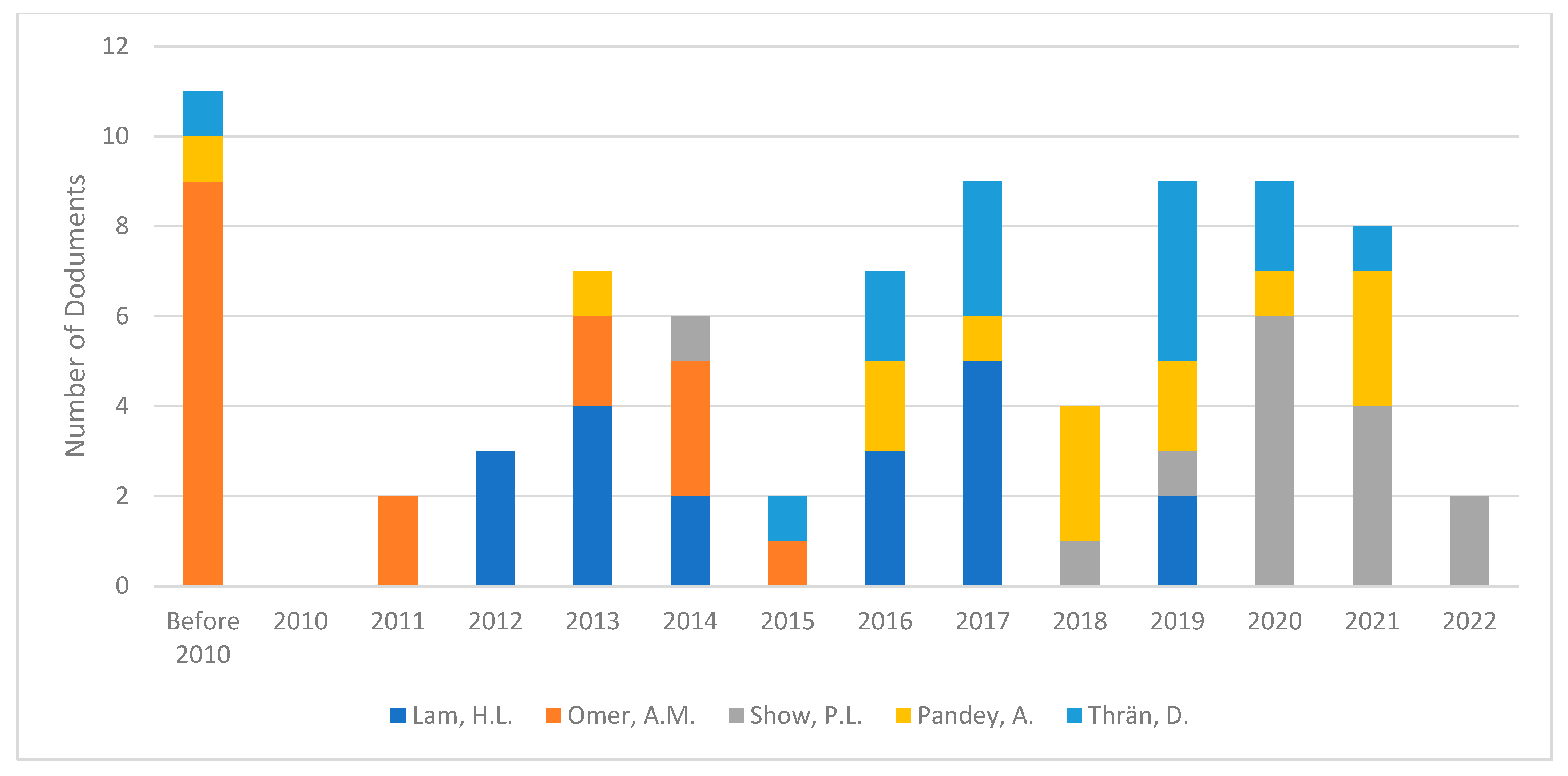
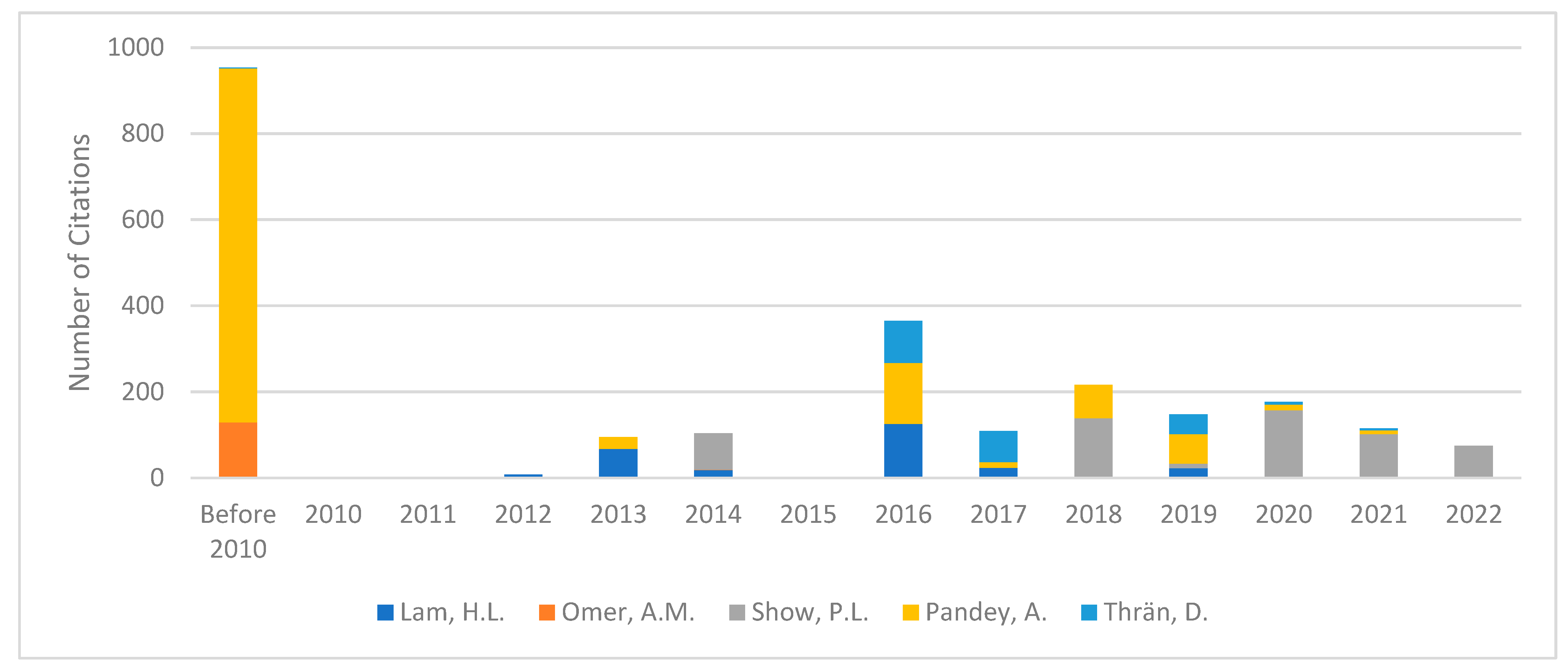
| Keywords | Total Link Strength | Occurrences | % |
|---|---|---|---|
| biomass | 44,545 | 3629 | 24.4 |
| biofuel | 21,639 | 1253 | 8.4 |
| fermentation & biogas & anaerobic digestion | 18,676 | 1146 | 7.7 |
| carbon dioxide & greenhouse gases | 14,647 | 1012 | 6.8 |
| energy utilization | 11,631 | 976 | 6.6 |
| nonhuman | 17,525 | 864 | 5.8 |
| algae & microalgae | 10,505 | 660 | 4.4 |
| carbon | 9130 | 561 | 3.8 |
| metabolism | 10,161 | 539 | 3.6 |
| lignin | 6817 | 466 | 3.1 |
| cellulose | 6933 | 466 | 3.1 |
| sustainable development | 5910 | 452 | 3 |
| bioenergy | 6052 | 419 | 2.8 |
| fossil fuels | 5503 | 407 | 2.7 |
| lignocellulosic biomass | 4643 | 350 | 2.4 |
| feedstocks | 4436 | 309 | 2.1 |
| microorganisms | 4589 | 293 | 2 |
| pyrolysis | 3731 | 292 | 2 |
| bioethanol | 4071 | 272 | 1.8 |
| wastewater treatment | 4386 | 265 | 1.8 |
| life cycle | 4522 | 255 | 1.7 |
| 1974–1999 | 2000–2009 | 2010–2021 | ||||||
|---|---|---|---|---|---|---|---|---|
| Subject | TP | % | Subject | TP | % | Subject | TP | % |
| Environment | 433 | 39.2 | Environment | 1570 | 38.9 | Energy | 9645 | 42.6 |
| Agriculture | 324 | 29.3 | Energy | 1277 | 31.6 | Environment | 9589 | 42.3 |
| Engineering | 322 | 29.1 | Agriculture | 961 | 23.8 | Engineering | 4879 | 21.5 |
| Energy | 271 | 24.5 | Chemical Eng. | 882 | 21.8 | Chemical Eng. | 4667 | 20.6 |
| Earth Sciences | 169 | 15.3 | Engineering | 720 | 17.8 | Agriculture | 4389 | 19.4 |
| Chemical Eng. | 145 | 13.1 | Biochemistry | 590 | 14.6 | Chemistry | 2342 | 10.3 |
| Biochemistry | 140 | 12.7 | Chemistry | 456 | 11.3 | Biochemistry | 2171 | 9.6 |
| Microbiology | 121 | 10.9 | Microbiology | 423 | 10.5 | Materials Science | 1162 | 5.1 |
| Chemistry | 41 | 3.7 | Earth Sciences | 311 | 7.7 | Physics | 1103 | 4.9 |
| Physics | 31 | 2.8 | Physics | 215 | 5.3 | Microbiology | 1100 | 4.9 |
| Journal | Year of Launch * | TP | Publisher | Country | H Index | SJR |
|---|---|---|---|---|---|---|
| Renewable and Sustainable Energy Reviews | 1997– | 249 | Elsevier | United Kingdom | 249 | 3.52 (Q1) |
| Bioresource Technology | 1990– | 208 | Elsevier | United Kingdom | 294 | 2.49 (Q1) |
| Journal of Cleaner Production | 1993– | 166 | Elsevier | United Kingdom | 200 | 1.94 (Q1) |
| Biomass and Bioenergy | 1991– | 153 | Elsevier | United Kingdom | 180 | 1.04 (Q1) |
| Renewable Energy | 1991– | 97 | Elsevier | United Kingdom | 191 | 1.83 (Q1) |
| Biotechnology for Biofuels | 2008– | 83 | BMC | United Kingdom | 93 | 1.44 (Q1) |
| Energy | 1976– | 83 | Elsevier | United Kingdom | 193 | 1.96 (Q1) |
| Science of the Total Environment | 1970, 1972– | 77 | Elsevier | Netherlands | 244 | 1.80 (Q1) |
| Fuel | 1922, 1970– | 71 | Elsevier | Netherlands | 213 | 1.56 (Q1) |
| Energies | 1975–1976, 2009– | 66 | MDPI | Switzerland | 93 | 0.60 (Q2) |
Publisher’s Note: MDPI stays neutral with regard to jurisdictional claims in published maps and institutional affiliations. |
© 2022 by the authors. Licensee MDPI, Basel, Switzerland. This article is an open access article distributed under the terms and conditions of the Creative Commons Attribution (CC BY) license (https://creativecommons.org/licenses/by/4.0/).
Share and Cite
Sertolli, A.; Gabnai, Z.; Lengyel, P.; Bai, A. Biomass Potential and Utilization in Worldwide Research Trends—A Bibliometric Analysis. Sustainability 2022, 14, 5515. https://doi.org/10.3390/su14095515
Sertolli A, Gabnai Z, Lengyel P, Bai A. Biomass Potential and Utilization in Worldwide Research Trends—A Bibliometric Analysis. Sustainability. 2022; 14(9):5515. https://doi.org/10.3390/su14095515
Chicago/Turabian StyleSertolli, Ardit, Zoltán Gabnai, Péter Lengyel, and Attila Bai. 2022. "Biomass Potential and Utilization in Worldwide Research Trends—A Bibliometric Analysis" Sustainability 14, no. 9: 5515. https://doi.org/10.3390/su14095515
APA StyleSertolli, A., Gabnai, Z., Lengyel, P., & Bai, A. (2022). Biomass Potential and Utilization in Worldwide Research Trends—A Bibliometric Analysis. Sustainability, 14(9), 5515. https://doi.org/10.3390/su14095515









